Deepseek Ai News Hopes and Dreams
페이지 정보
작성자 Aaron 작성일 25-03-07 22:08 조회 79 댓글 0본문

 Expanding scope of chip restrictions on China: DeepSeek admits that constrained entry to GPUs on account of US export controls is a significant impediment to its progress however evidently cobbled together a big enough compute cluster to develop its V3 and R1 fashions. As Chinese AI startup DeepSeek attracts attention for open-supply AI fashions that it says are cheaper than the competitors while offering related or better efficiency, AI chip king Nvidia’s inventory worth dropped at this time. Chinese AI startup DeepSeek on Saturday disclosed some value and income knowledge associated to its hit V3 and R1 models. Let’s discuss privateness. DeepSeek has faced scrutiny in South Korea over information privateness issues, making it a questionable selection for customers dealing with delicate knowledge. In concept, these restrictions ought to pose a extreme challenge to China’s skill to continue producing homegrown AI chips, as Huawei’s Ascend AI processors are wholly dependent on HBM imports from Korea. It also created license exemptions for "Supplement 4" companion nations, together with Germany, and imposed US restrictions on nations like South Korea and Singapore unless they align with US export controls.2 This now turns into a question of enforcement and prioritization for the Trump administration, which has already shown a penchant for openly threatening lengthy-standing US allies with tariffs and withdrawal of safety cooperation when pushing its demands.
Expanding scope of chip restrictions on China: DeepSeek admits that constrained entry to GPUs on account of US export controls is a significant impediment to its progress however evidently cobbled together a big enough compute cluster to develop its V3 and R1 fashions. As Chinese AI startup DeepSeek attracts attention for open-supply AI fashions that it says are cheaper than the competitors while offering related or better efficiency, AI chip king Nvidia’s inventory worth dropped at this time. Chinese AI startup DeepSeek on Saturday disclosed some value and income knowledge associated to its hit V3 and R1 models. Let’s discuss privateness. DeepSeek has faced scrutiny in South Korea over information privateness issues, making it a questionable selection for customers dealing with delicate knowledge. In concept, these restrictions ought to pose a extreme challenge to China’s skill to continue producing homegrown AI chips, as Huawei’s Ascend AI processors are wholly dependent on HBM imports from Korea. It also created license exemptions for "Supplement 4" companion nations, together with Germany, and imposed US restrictions on nations like South Korea and Singapore unless they align with US export controls.2 This now turns into a question of enforcement and prioritization for the Trump administration, which has already shown a penchant for openly threatening lengthy-standing US allies with tariffs and withdrawal of safety cooperation when pushing its demands.
Deemed America’s "Sputnik moment" by tech billionaire Marc Andreessen, the Chinese firm had created China’s first groundbreaking tech innovation that may doubtless have Americans copying the Chinese, quite than the other way around. Assumption 1: US chip controls will throttle Chinese indigenous chip manufacturing, widening the US lead in foundational AI hardware. So long because the US maintains a monopoly in excessive-performance chips, it theoretically has the foundational prowess to widen its technological lead with China and the leverage to globally allocate advanced compute to the rest of the world as it sees match. AI, experts warn fairly emphatically, may quite literally take control of the world from humanity if we do a bad job of designing billions of tremendous-smart, tremendous-highly effective AI agents that act independently in the world. BIS already laid the groundwork for extraterritorial enforcement in the December 2, 2024 chip controls, which included a "single chip" de minimis provision designed to assert US writ over instruments made in any factory wherever in the world that incorporates a single US chip (see December 9, "Slaying Self-Reliance: US Chip Controls in Biden’s Final Stretch"). The high-bandwidth reminiscence (HBM) chokepoint: On December 2, 2024, BIS imposed broad restrictions on the export to China of all generations of HBM at the moment in production.
DeepSeek-V3, a big foundation model that was released in late December 2024 and serves as the bottom model for R1, launched a handful of novel algorithmic optimizations that considerably reduce the price of each training and deploying DeepSeek’s models. DeepSeek, a Chinese AI firm, recently launched a brand new Large Language Model (LLM) which appears to be equivalently capable to OpenAI’s ChatGPT "o1" reasoning mannequin - essentially the most refined it has out there. Ollama lets us run giant language models domestically, it comes with a fairly easy with a docker-like cli interface to start out, cease, pull and listing processes. So though Deep Seek’s new mannequin R1 could also be extra efficient, the fact that it's one of those type of chain of thought reasoning fashions could end up utilizing more vitality than the vanilla type of language models we’ve truly seen. In their view, export controls that self-prohibit servicing will only enable China to more quickly reduce its dependency on foreign toolmakers, whereas depriving non-Chinese SME companies of beneficial visibility into how their equipment is getting used within Chinese fabs and how China’s semiconductor manufacturing capabilities are progressing more broadly. It is going to be a number of millions of US residents who will find yourself with the quick stick.
- 이전글 These 5 Simple Deepseek Chatgpt Methods Will Pump Up Your Gross sales Nearly Immediately
- 다음글 5 Super Useful Tips To Improve Daycare Near Me
댓글목록 0
등록된 댓글이 없습니다.
